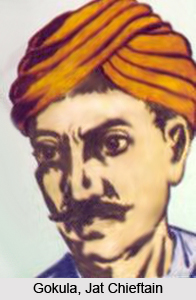 Gokula, also known as Gokul Singh, was a Jat chieftain belonging to the Sinsini village located at Bharatpur district in Rajasthan. He assumed the position of the chieftain of Tilpat in Haryana. His father was Madu and he had three siblings namely Sindhuraj, Jhaman and Saman. Gokul was the second son of Madu and his original name was Ola but he later gained popularity with the name of Gokula. Gokula had challenged the imperial power along with the Jat peasants by being a leader. He played a crucial role in inspiring the Jats to battle against the Mughals.
Gokula, also known as Gokul Singh, was a Jat chieftain belonging to the Sinsini village located at Bharatpur district in Rajasthan. He assumed the position of the chieftain of Tilpat in Haryana. His father was Madu and he had three siblings namely Sindhuraj, Jhaman and Saman. Gokul was the second son of Madu and his original name was Ola but he later gained popularity with the name of Gokula. Gokula had challenged the imperial power along with the Jat peasants by being a leader. He played a crucial role in inspiring the Jats to battle against the Mughals.
Jat Rebellion in Mathura
The first outbreak of struggle which marked the anti imperial reaction occurred on the part of Jats of Mathura district in Uttar Pradesh who were greatly oppressed by the imperial faujdar, Abdunnabi. The year 1669 was marked by the rise of Jat peasantry under the leadership of Gokula. Although the faujdar was killed in the revolt, the district could not maintain its independence for more than a year and the Jat peasants were once again suppressed by the new faujdar of Mathura, Hasan Ali Khan. He was also assisted personally by the Mughal Emperor Aurangzeb.
Expedition of Aurangzeb against Hindu Religion
The attempt of the Mughal Emperor Aurangzeb for converting Dar-ul-Hurb (Hindustan) to Dar-ul-Islam forcefully through rigid and persecution policies brought Gokula to prominence. The 1669, the country witnessed a Jat uprising under the leadership of Gokula, a time when Mughal Empire assumed a strong authority. During this phase, however, the Mughal dynasty was experiencing its climax under the rule of Aurangzeb. The early medieval period often encountered law and order breakdown which appealed the Jats to adopt a refractory course. But as the Mughal rule started to stabilize their administration, the Jat revolts got suppressed. In 1638, the Mughal faujdar of Mathura named Murshid Quli Khan got executed during an expedition against the Jats. During the rule of Aurangzeb, in 1669, another faujdar of Mathura named Abdunnabi further garnered hostility with the people. Abdunnabi was in fact appointed to curb the Hindus of the region. He set up his cantonment near the area of Gokul Singh and began carrying out his operations from there.
Owing to this, Gokula encouraged the farmers to refuse the payment of taxes to the Mughals. The retaliation of the Mughal soldiers over the refusal further instigated the farmers to struggle against them. On 9th April 1669, orders were issued by Aurangzeb for demolishing the Hindu temples which was followed by the destruction of a number of ancient heritages and Hindu temples belonging to Kushana period. The village of Sihora was seized by the faujdar Abdunnabi in May 1669. This led to a fight between Gokula and Abdunnabi in which the latter was killed. Following this, Gokula marched further along with his fellow farmers and ruined the Sadabad cantonment. This inspired the other Hindus to battle against the Mughal Empire which continued for about five months.
Conflict between Mughals and Jat Rebels
The Jat rebellion led by Gokula also included other communities such as Panwar, Naruka, Gujjar, Ahir, Meena and Mev and all gathered at the village of Sahora. There they were attacked by Abdunnabi. Initially he was overpowering the rebels but was later killed on 12 May 1669. This turbulence reached up to Agra district where Radandaz Khan was sent to combat the rebellion. Saf Shikan Khan was then appointed by Aurangazeb as the new faujdar of Mathura. When the Mughal forces got defeated in arms, they tried diplomatic ways and offered forgiveness to the Jat rebels against the surrender of Gokula. This proposal was however turned down by Gokula and the Mughal Emperor himself marched towards the area of disturbance. He also dispatched Hasan Ali Khan for attacking a several centres of rebellion which resulted in a severe fight, killing several imperialists as well as rebels. However when Hasan Ali Khan went back to the Emperor with many prisoners, the impressed king made him the faujdar of Mathura in place of Saf Shikan Khan as the latter failed to suppress the rebellions. Later the faujdar of the environs of Agra, named Amanulla, also assisted Hasan Ali in suppressing the rebels.
Death of Gokula
During this phase, Gokula rushed to fight against the imperialists near Tilpat. The trained army of Mughals in the battle forced the retreat of the rebels to Tilpat where they were chased by Hasan Ali. The battle continued for about 4 days and in this bloody conflict the Mughals won but lost about 4000 men in the tough struggle offered by the rebels. Subsequently Gokula Jat was attacked by Hasan Ali khan and was captured alive along with his two associates. On 1st January 1670 the furious emperor ordered the execution of Gokula and his associates.



















